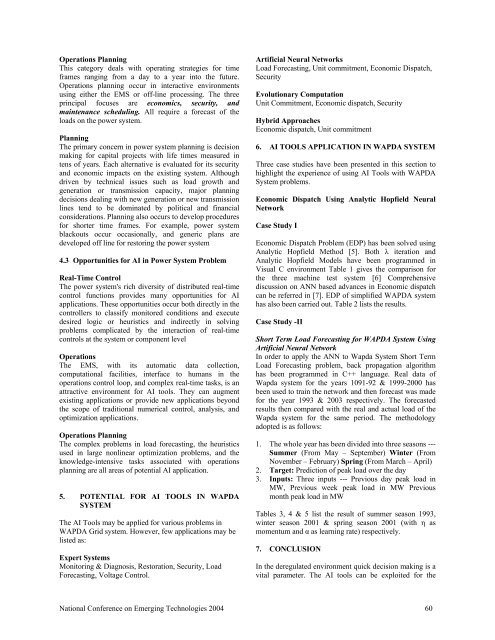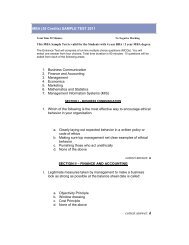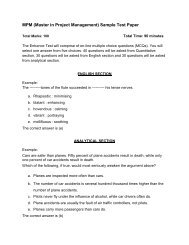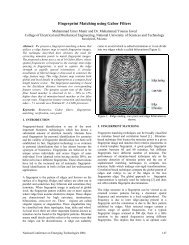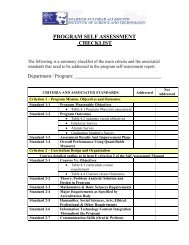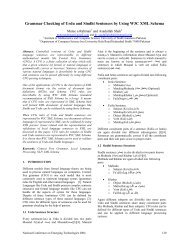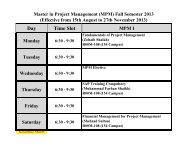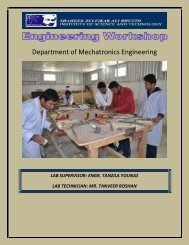Potential of Artificial Intelligence (AI) Techniques for ... - CiteSeerX
Potential of Artificial Intelligence (AI) Techniques for ... - CiteSeerX
Potential of Artificial Intelligence (AI) Techniques for ... - CiteSeerX
You also want an ePaper? Increase the reach of your titles
YUMPU automatically turns print PDFs into web optimized ePapers that Google loves.
Operations Planning<br />
This category deals with operating strategies <strong>for</strong> time<br />
frames ranging from a day to a year into the future.<br />
Operations planning occur in interactive environments<br />
using either the EMS or <strong>of</strong>f-line processing. The three<br />
principal focuses are economics, security, and<br />
maintenance scheduling. All require a <strong>for</strong>ecast <strong>of</strong> the<br />
loads on the power system.<br />
Planning<br />
The primary concern in power system planning is decision<br />
making <strong>for</strong> capital projects with life times measured in<br />
tens <strong>of</strong> years. Each alternative is evaluated <strong>for</strong> its security<br />
and economic impacts on the existing system. Although<br />
driven by technical issues such as load growth and<br />
generation or transmission capacity, major planning<br />
decisions dealing with new generation or new transmission<br />
lines tend to be dominated by political and financial<br />
considerations. Planning also occurs to develop procedures<br />
<strong>for</strong> shorter time frames. For example, power system<br />
blackouts occur occasionally, and generic plans are<br />
developed <strong>of</strong>f line <strong>for</strong> restoring the power system<br />
4.3 Opportunities <strong>for</strong> <strong>AI</strong> in Power System Problem<br />
Real-Time Control<br />
The power system's rich diversity <strong>of</strong> distributed real-time<br />
control functions provides many opportunities <strong>for</strong> <strong>AI</strong><br />
applications. These opportunities occur both directly in the<br />
controllers to classify monitored conditions and execute<br />
desired logic or heuristics and indirectly in solving<br />
problems complicated by the interaction <strong>of</strong> real-time<br />
controls at the system or component level<br />
Operations<br />
The EMS, with its automatic data collection,<br />
computational facilities, interface to humans in the<br />
operations control loop, and complex real-time tasks, is an<br />
attractive environment <strong>for</strong> <strong>AI</strong> tools. They can augment<br />
existing applications or provide new applications beyond<br />
the scope <strong>of</strong> traditional numerical control, analysis, and<br />
optimization applications.<br />
Operations Planning<br />
The complex problems in load <strong>for</strong>ecasting, the heuristics<br />
used in large nonlinear optimization problems, and the<br />
knowledge-intensive tasks associated with operations<br />
planning are all areas <strong>of</strong> potential <strong>AI</strong> application.<br />
5. POTENTIAL FOR <strong>AI</strong> TOOLS IN WAPDA<br />
SYSTEM<br />
The <strong>AI</strong> Tools may be applied <strong>for</strong> various problems in<br />
WAPDA Grid system. However, few applications may be<br />
listed as:<br />
Expert Systems<br />
Monitoring & Diagnosis, Restoration, Security, Load<br />
Forecasting, Voltage Control.<br />
<strong>Artificial</strong> Neural Networks<br />
Load Forecasting, Unit commitment, Economic Dispatch,<br />
Security<br />
Evolutionary Computation<br />
Unit Commitment, Economic dispatch, Security<br />
Hybrid Approaches<br />
Economic dispatch, Unit commitment<br />
6. <strong>AI</strong> TOOLS APPLICATION IN WAPDA SYSTEM<br />
Three case studies have been presented in this section to<br />
highlight the experience <strong>of</strong> using <strong>AI</strong> Tools with WAPDA<br />
System problems.<br />
Economic Dispatch Using Analytic Hopfield Neural<br />
Network<br />
Case Study I<br />
Economic Dispatch Problem (EDP) has been solved using<br />
Analytic Hopfield Method [5]. Both λ iteration and<br />
Analytic Hopfield Models have been programmed in<br />
Visual C environment Table 1 gives the comparison <strong>for</strong><br />
the three machine test system [6] Comprehensive<br />
discussion on ANN based advances in Economic dispatch<br />
can be referred in [7]. EDP <strong>of</strong> simplified WAPDA system<br />
has also been carried out. Table 2 lists the results.<br />
Case Study -II<br />
Short Term Load Forecasting <strong>for</strong> WAPDA System Using<br />
<strong>Artificial</strong> Neural Network<br />
In order to apply the ANN to Wapda System Short Term<br />
Load Forecasting problem, back propagation algorithm<br />
has been programmed in C++ language. Real data <strong>of</strong><br />
Wapda system <strong>for</strong> the years 1091-92 & 1999-2000 has<br />
been used to train the network and then <strong>for</strong>ecast was made<br />
<strong>for</strong> the year 1993 & 2003 respectively. The <strong>for</strong>ecasted<br />
results then compared with the real and actual load <strong>of</strong> the<br />
Wapda system <strong>for</strong> the same period. The methodology<br />
adopted is as follows:<br />
1. The whole year has been divided into three seasons ---<br />
Summer (From May – September) Winter (From<br />
November – February) Spring (From March – April)<br />
2. Target: Prediction <strong>of</strong> peak load over the day<br />
3. Inputs: Three inputs --- Previous day peak load in<br />
MW, Previous week peak load in MW Previous<br />
month peak load in MW<br />
Tables 3, 4 & 5 list the result <strong>of</strong> summer season 1993,<br />
winter season 2001 & spring season 2001 (with η as<br />
momentum and α as learning rate) respectively.<br />
7. CONCLUSION<br />
In the deregulated environment quick decision making is a<br />
vital parameter. The <strong>AI</strong> tools can be exploited <strong>for</strong> the<br />
National Conference on Emerging Technologies 2004 60


